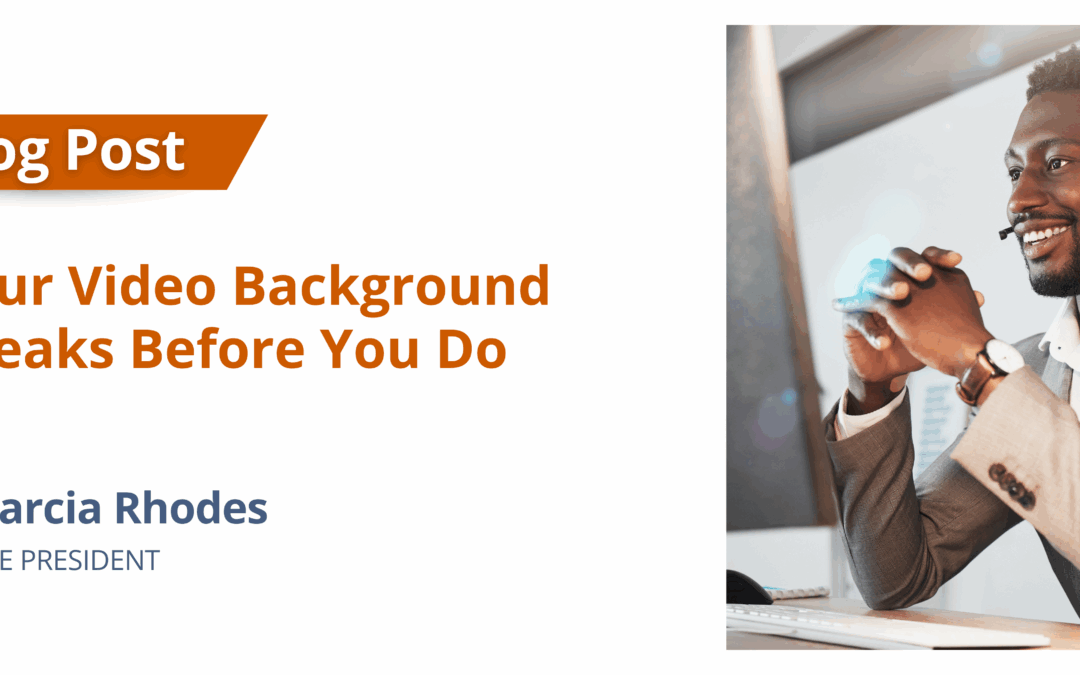
by Marcia Rhodes | Sep 17, 2025 | Blog
When it comes to video interviews, webinars, or executive briefings, it’s often the small details that leave the biggest impression. Reporters, clients, and colleagues notice more than you might think. Your appearance isn’t just about how you look — it’s also about what’s behind you.
Your video background communicates professionalism, attention to detail, and self-awareness. Done well, it can even create connection. Done poorly, it can undermine your credibility before you’ve spoken a word.
The following are a few pro tips to make sure your video background says the right things:
- Tidy Up Your Space
If you’re taking a call from a hotel room or temporary set-up, small details matter:
- Close the bathroom door
- Make the bed
- Remove visible clutter or personal items
Reporters and executives notice details more than you might expect. One client, for instance, left a stack of messy file folders teetering on the edge of his desk during a media interview. Instead of focusing on his insights, the journalist joked about him “needing to go paperless.” It became a distraction — and definitely not the impression he wanted to leave.
On the flip side, another client had framed artwork from his young kids behind him. Instead of being a distraction, it turned into a warm conversation starter with the reporter — humanizing him and creating rapport before the interview even began.
- Lighting is Key
Good lighting helps you appear clear and engaged. Poor lighting makes you look tired, shadowy, or unprofessional. Natural light works best, but if that’s not possible, invest in a ring light.
Ring lights are affordable and can even double as a desk light. Choose one with adjustable brightness and color temperature (so you can switch from warm to cool light). If you wear glasses, look for one with diffused lighting or try angling it to avoid glare.
- Virtual Background or Not?
Virtual backgrounds can be tempting, especially if you’re in a pinch. But they often glitch or create an unnatural “halo effect” around your head. Unless you’re using a branded or professional image that your computer handles flawlessly, PR pros generally advise against them.
Authenticity resonates. A neutral wall, bookshelf, or well-lit corner beats a digital beach scene every time. One client displayed an acrylic frame holding a small beanie cap. When the reporter asked about it, she explained it was what her daughter was wearing the day she passed away. The reporter was deeply moved — and the interview shifted from transactional to personal, shaping a much more meaningful piece.
- Do a Tech + Visual Check
Before the call:
- Open your video and review what your setup looks like
- Move distracting items out of the frame
- Make sure nothing odd is visible (an open closet, dishes, laundry, or even a pet sneaking in)
Think of it as a dress rehearsal for your space. If time allows, have your PR manager do a quick one-minute visual check before every call, ensuring not just your appearance but also that your background is ready. I once did a visual check with a client and saw that he had a poster in a foreign language behind him. I asked him what the slogan said and since he had no idea, we agreed to take it down to be safe.
Final Thought
Your video background doesn’t just fill the screen — it fills in the story about you. When it’s intentional, it can signal professionalism, warmth, or even humanity in ways that words alone can’t. Treat it as part of your communication strategy, not an afterthought.
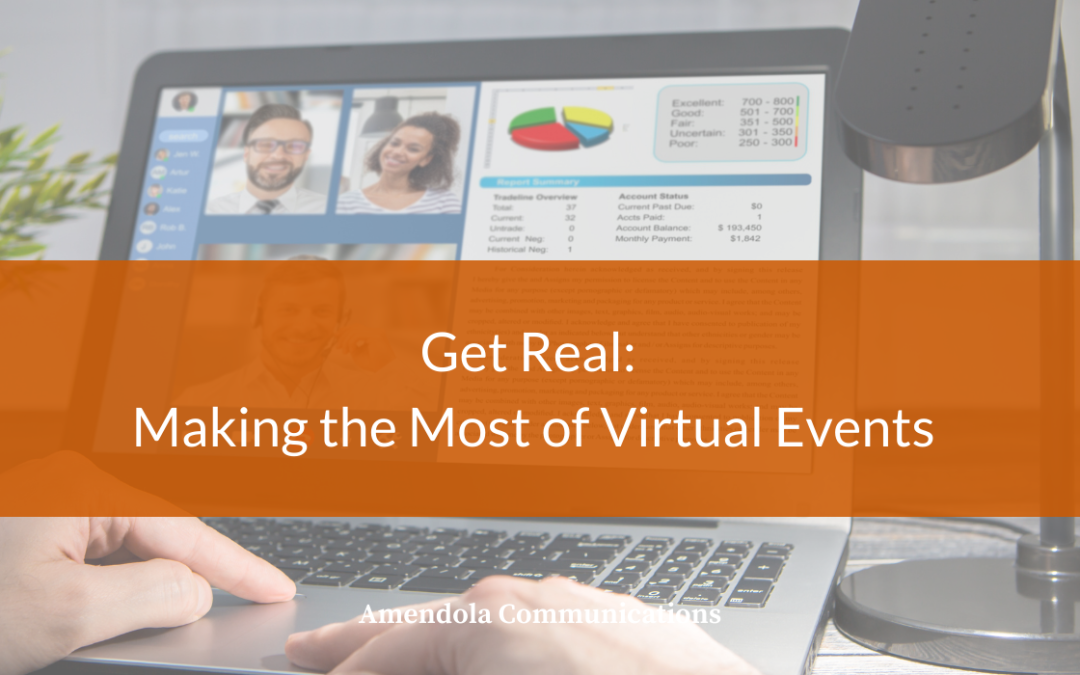
by Jodi Amendola | Oct 14, 2020 | Blog
Many healthcare, life sciences and healthcare IT marketers may not realize it, but virtual events (such as online-only conferences) are not new. They’ve actually been around for roughly a decade – starting right about the time broadband connections became ubiquitous.
But you never heard about them? That’s not surprising, because they were pretty much treated as “less than” events. They were the sort of thing organizers would do when they didn’t have the resources to pull off a live event such as HIMSS, and organizations would participate in when they didn’t have the budget or personnel to attend live events.
Then came the COVID-19 pandemic and suddenly virtual conferences and other digital-only events started looking a whole lot more attractive, even to the big players.
That’s the world we live in for now. With many states restricting attendance at indoor events to a maximum of 50 people, it’s unlikely that we will be gathering together face-to-face anytime soon.
As someone who has walked countless concrete floors in countless poorly ventilated halls in countless cities across this great nation, I can tell you that’s not all bad news. My feet have never felt better as an adult, and my shoes have lasted far longer than they usually do.
Of course, even if the ability to hold in-person conferences and other events has been curtailed that doesn’t mean the need has gone away. And suddenly, almost overnight, virtual conferences (and other virtual events) have gone from fighting for scraps in marketing budgets to being front-and-center in many organizations’ plans.
Since it appears we’re going to be stuck in COVID-19 limbo for the foreseeable future, savvy marketers will want to learn the best ways to take advantage of these virtual events opportunities. Fortunately, I addressed this very topic in a recent post for the Forbes Agency Council blog, which you can read here:
https://bit.ly/33y3zEy
In it I cover not only ways to maximize the benefits of virtual conferences but also other types of virtual events such as webinars, various forms of content and even video conferences.
Instead of pining for the days of stale, overpriced sandwiches, never-ending, never-moving taxi lines and nondescript hotel rooms where previous guests clearly violated the “no smoking” rules, give the post a look. And afterwards, if you find you need some help in executing some of these ideas for virtual events, give me a call or shoot me a note. My Zoom is always open.
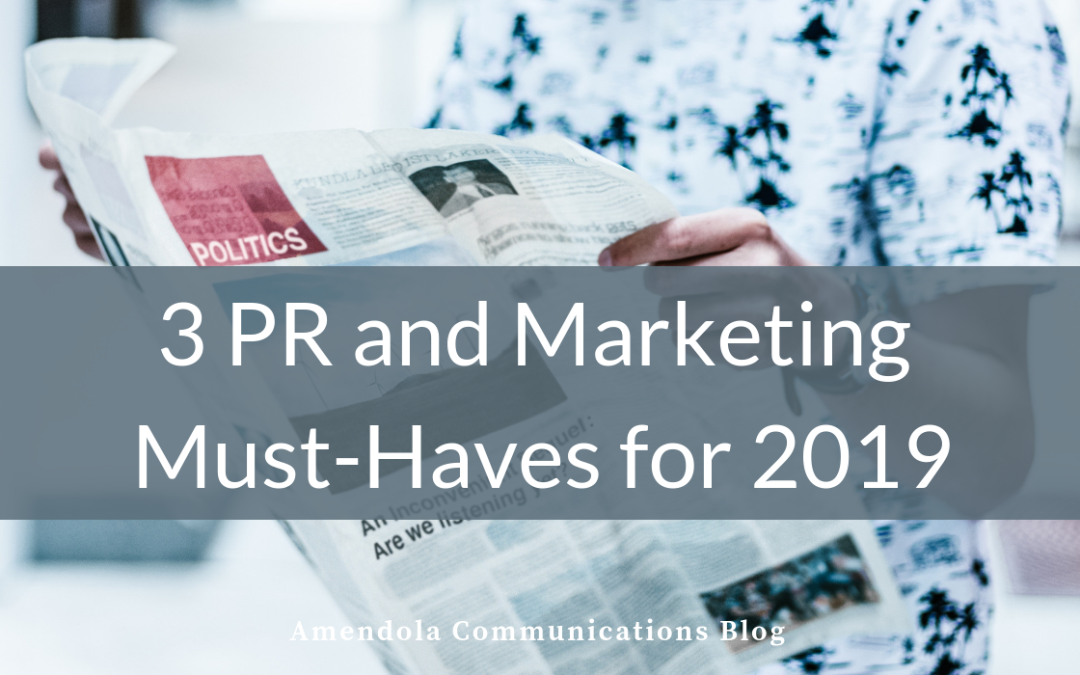
by Heather Caouette | Oct 10, 2018 | Blog
The signs of autumn are all around us shorter days, pumpkin spice in abundance and 2019 budgets looming over our heads. Take this opportunity to revitalize your efforts. There are some evergreen items that are important to any successful marketing and public relations campaign, including pertinent social media, thought provoking content and strong media relations programs. However, what additional PR and marketing must-haves can you explore now to supplement these programs and make sure the budget is in place for them in the coming year?
As we say goodbye to summer, there are a few additional initiatives that are essential to giving your company an additional marketing edge:
- Website refresh: A bit like spring cleaning, updating your website is a chance to rejuvenate it, make sure the messaging projected is current along with any facts and figures that are used. Still citing 2008 statistics? Time to find new content. Verify links and calls to action, ensuring they are all still relevant. Criteria to enhance SEO benefits are always being updated, so this is a chance to check meta tags, keywords and make sure that your site adheres to Google’s Mobile First push, which uses the mobile version of a site’s content to rank pages from that site. Adding fresh content, including blogs and video, helps with your search ranking and keeps visitors returning for more.
- Webinars: Continue building thought leadership and trust with your target audiences through webinars. Increase brand awareness and get your messaging across while adding a human element to your company. People often view speakers as authorities on a given topic, so take this opportunity to show your knowledge. Webinars also are a chance to gather information on potential leads to supplement your sales funnel. These sessions can be recorded for future use and repurposed into whitepapers, eBooks, blogs or bylined article. Video bites can be captured and shared on your website and social media.
- Customer testimonials: A recent study found that 86 percent of respondents felt online reviews were extremely, very or moderately important before making a purchasing decision. No matter how good you are, it carries more weight if someone else says it. Whether via text or video, having the people that use your product discuss how it helps them humanizes your company, lends credibility and illustrates the power of your solutions. These “reports from the field” give media and sales prospects narratives about how a solution is applied in a real-world situation and serve as tools for your sales team, along with fresh content for your website, lead generation and social media efforts.
These three tactics each have value on their own, work well together and will enhance an established public relations program or kick-start a new one. Better yet, there is no “one size fits all” approach to any of the above programs, so they can be tailored to your comfort level. Start at one level and scale up once you see results. Use your 2019 budget to employ tactics that will establish brand loyalty.
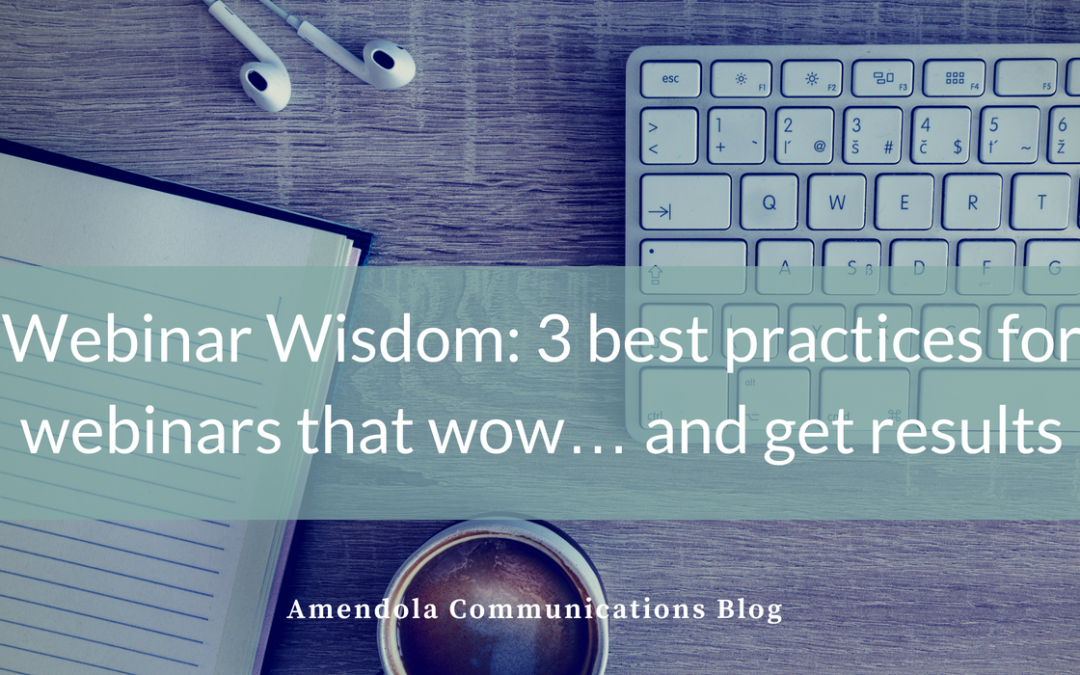
by Lisa Chernikoff | Aug 1, 2018 | Blog
I have a confession. I’m not ashamed. It’s my truth. I love a webinar. I love everything about it. I love writing the title and description. I love promoting it and watching the registration count rise each day. I love when the day finally arrives and the presentation comes to life.
I even love the items on the post-webinar to-do list like sending the follow-up emails to keep the audience engaged, warming up the leads for the sales team or converting them into new sales opportunities. Yes, that’s really why I love webinars. I love the results and by that, I mean the results when everything is done right.
However, I’ve found that many marketing and PR professionals don’t share my pro-webinar passion. In fact, much to my horror and astonishment, many of them are firmly planted in the anti-webinar camp. But I understand their point of view. Most likely, they have been discouraged by a webinar that fell flat, or they simply don’t understand how to harness the true power of a webinar.
As a lover of webinars, with a successful track record over the last decade, I’m here to help with some tried-and-true best practices.
Create customer-focused content
There is almost no better forum than a webinar to highlight your customer’s successes. Why? It’s much different to just read a case study than to have your customers verbally share their stories. On a webinar, attendees can experience that case study live, identify with the challenges and celebrate in the successes which could soon become their own successes with the help of your company.
Now, having a customer co-presenter is the best-case scenario. We know that complete, fully baked customer case studies can be hard to come by or even nearly impossible when companies are launching new products. But there is incredible power in a customer case study that’s still in progress as well. Whether the journey has just begun or the results are preliminary, it’s still better for attendees to hear from their peer rather than just your team.
Webinars with customer co-presenters are almost always more well-attended and more successful. Plus, with customer co-presenters, your company also benefits from being associated with your customer names and brands. Even if someone doesn’t attend your webinar, they may remember that you work with that top hospital.
Prepare for an interactive experience
Even though a webinar is somewhat similar to any other speaking engagement, it’s technically much different. It’s challenging to speak into the phone rather than speak into a crowd of faces that may be either nodding their heads in agreement or nodding off out of boredom. That’s why it’s so important to leverage the technology to create an interactive experience that benefits both your attendees and your speakers.
Even the most basic webinar platforms offer a polling feature which should be used 2-4 times throughout the webinar. We often recommend to clients that they start with a poll question to get a better understanding of what the attendees are looking to learn or why they chose to attend. It can also be helpful for the initial poll question to serve as a gauge for understanding the “level” of attendees. For example, how would they rate their organization’s progress on the journey to value?
Also, did you know that one of the easiest, most painless ways to drive future registrations is right at your fingertips during each webinar? At the end of your presentation, while you still have a captive and hopefully happy audience, simply invite attendees to the next relevant session in your webinar series. When sessions are monthly or quarterly, attendees who enjoyed your webinar usually will vote “yes” via a poll to be automatically registered for the next session.
Focus on follow-up, not just promotion
Lastly, it’s incredibly common for even some of the savviest marketers to focus almost entirely on webinar promotion rather than placing equal importance on the webinar follow-up communications. Don’t neglect the attendees who just spent 30-minutes or an hour with you! They are now primed and ready for more so it’s mission critical to send timely (ideally within 24 hours or less but 48 hours max) follow-up emails to attendees and those who registered but didn’t attend.
It’s also important to send them more than just the webinar recording or the slides. Perhaps you can offer them a new eBook about best practices featured on the webinar or you may have a written case study to share on the same topic. It’s not always about having new content to share. It’s about having relevant content to share and becoming a go-to expert.
Regardless, it’s important for your follow-up communication to be educational and informative to drive continued engagement. After all, once someone spends an hour with you via a webinar, they are more invested. Now it’s about keeping them invested in your content, your customers and most importantly, your company.
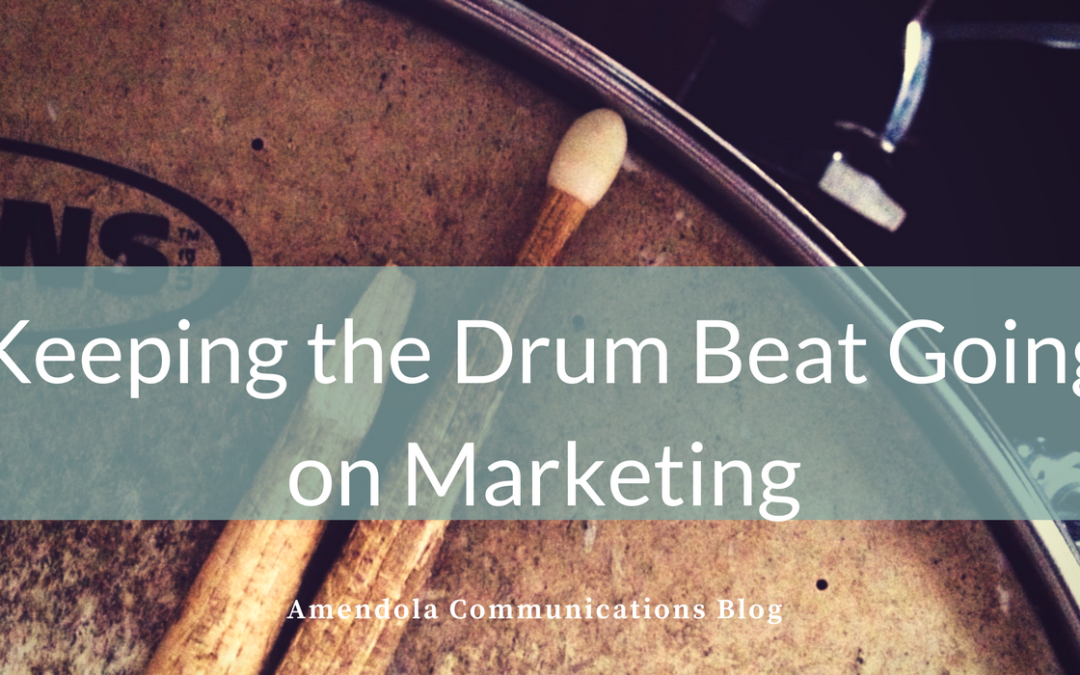
by Heather Caouette | Jul 12, 2017 | Blog
Summer conjures many images that are symbolic of a slower pace relaxing by the beach, sipping lemonade by the pool or reading a book under the shade of a tree. These relaxing pictures of a simpler time rarely include your marketing efforts, although they can fall into this summer haze if you don’t take steps to keep them amped up and the drum beat cadence strong.
New customer wins, moving into an expanded headquarters and launching innovative products are obvious reasons to keep your name in the public eye; however, summer seems to have a way with slowing down major events such as these. How do you stay in front of your main audiences without appearing overly promotional?
Conduct Surveys Can you survey your customers to discover a new point of view? Do you have access to de-identified data within your product that could point to an industry trend? One example would be discovering which state’s residents are more likely to take their medication as prescribed than in any other state. Facts and figures are generally well-received and can support your company’s position. These results can be used for a press release, infographic, social media and media relations outreach.
Create a Campaign Develop videos, blog posts or other content addressing problems that your product solves and position yourself as a thought leader. Champion a cause or highlight a struggle like Healthsparq’s #WhatTheHealthcare and athenahealth’s #LetDoctorsBeDoctors campaigns. Branch out as a mover and a shaker to help fix a problem even if your product alone won’t do the trick. Doing this shows you as a trusted ally and advocate.
Offer a Fresh Perspective Your company has knowledge and a viewpoint that is unique. Does your CEO have a fresh position on leadership? What insights can you bring on the industry? Refine that information and share it through media relations, webinars and bylines. Reporters are looking for new ideas that shed light on a relevant topic in a vendor-neutral manner.
Whether done on your own, with a customer or through partnering with a publication, webinars are a great avenue to harness your knowledge about a topic and share it in a way that gives a personal connection. Attendees can get a taste of your personality, in addition to knowledge on the topic, and the chance to ask questions depending on how the session is structured. Contributing articles to publications is also a great way to extend thought leadership by sharing your perspective in your voice.
Support a Charity There are many great causes. Perhaps your company already supports a charity, which would benefit from an event or donation. Another option is to find an organization that allows personal involvement, such as sponsoring a build day with a Habitat for Humanity site near your office. Not only will it be a great team-building exercise, you could get some local press for your efforts. Employees and customers enjoy working with socially responsible companies, so it is a win from all sides.
Everyone hits a slow news cycle at some point. Use this time to refine your position, create a conversation and support a great cause. Each of these methods will extend your brand and deliver more content, including for your social channels.




